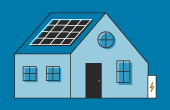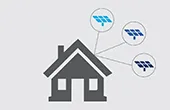Over the last few years, solar capacity in the United States has truly taken off. Over 58 gigawatts (or million kilowatts) of solar capacity are currently installed across nearly 2 million projects, and at least 3.7 gigawatts more are in the pipeline as of late 2018. At the same time, the fate of nuclear power in the country is at a crossroads. Only one single nuclear unit has been completed in the U.S. since the 1990s, and the two most recent projects are experiencing delays, cost overruns, and ultimately cancellations.
Continue readingSolar for tiny houses: what you need to know
In an effort to minimize energy usage (and possession of material items), homeowners across the country are moving into tiny houses. Even though these houses are much smaller than the average home, they still need energy for lighting, heating, cooling, and other appliances. If you’re living in or planning to build a tiny house, you can cut your energy bills even further by generating your own clean, free electricity with solar panels.
Continue readingSolar news: February 8th, 2019
In this week’s Solar News Roundup, Massachusetts moves forward with a new incentive structure for battery storage, and SunPower begins operations at an old SolarWorld facility.
Continue readingBlack start: why it matters
The electrical grid is designed with redundancy in mind. In order to avoid any consumers losing power, and especially any prolonged drops in power, utilities and the grid operators have designed backup plans and backups to those backups. Although very rarely, if ever, necessary, the last of those backup plans is perhaps the most important of all: black start resources.
What is black start?
Continue readingPros and cons of electric water heaters
Heating water in your house requires a lot of electricity. In fact, roughly 12 percent of an average home’s energy consumption is spent heating water. How much energy your own water heater consumes depends not only on how much hot water you use but also on the type of water heater you install. As such, when it’s time to install a new water heater in your home, it’s important to compare multiple options before making a final purchasing decision.
Continue readingSolar news: January 25th, 2019
In this week’s Solar News Roundup, one of the country’s largest utilities makes an exciting commitment to solar, plus a case study on the transition from fossil fuels to solar energy.
Continue readingSol Systems review: what you need to know
Solar energy renewable certificates (SRECs) are some of the most attractive solar incentives available in the country. Many states with renewable portfolio standards (RPS) have special “solar carve-outs” that require a certain amount of a utility’s energy production to come from solar. In these states, utility companies meet the requirement by purchasing SRECs from people producing solar energy.
If you own a solar panel system in a state with an active SREC market, you’ll want to work with a third-party SREC aggregator or broker to sell the certificates to utilities on your behalf. There are a variety of options when it comes to choosing an SREC broker; one of the more popular options solar panel system owners elect to work with is Sol Systems.
Continue readingInstalling solar panels on different roof types
If you’re considering installing a residential or commercial solar panel system, you might be wondering if your roof type is appropriate for a solar installation. The good news is that solar panels can be installed on just about any roof type, but the installation process and mounting hardware might vary from material to material. In this article, we’ll explore the many types of roofs solar panels can be installed on and how each has a unique installation process.
Continue readingWhat are microgrids and how do they work?
As more and more customers express interest in solar plus storage on EnergySage’s Marketplace, many do so with the same intended purpose: resiliency. When the grid goes dark, these solar shoppers want to ensure that they are on an electric “island” to keep their own lights on, self-generating and storing solar electricity that they can then consume. The solution? Microgrids.
Partially in response to major storm events nationwide, this innovative, if not new, approach is being taken throughout the country to maintain greater reliability and to return power quicker at the local level. By taking the notion of an electrical island from a single home to multiple buildings or an entire community, communities, cities, and organizations are creating microgrids.
Continue readingHeating and cooling degree days
Degree days are a way to measure how warm or cold a region is. When it comes to energy, knowing about the heating degree days or cooling degree days your location experiences can help you understand how much energy you might need to use for home climate systems. In this article, we take a look at both cooling degree days and heating degree days and their impact on your energy use, plus potential ways to shift your behavior based on the degree days in your region.
Continue reading




